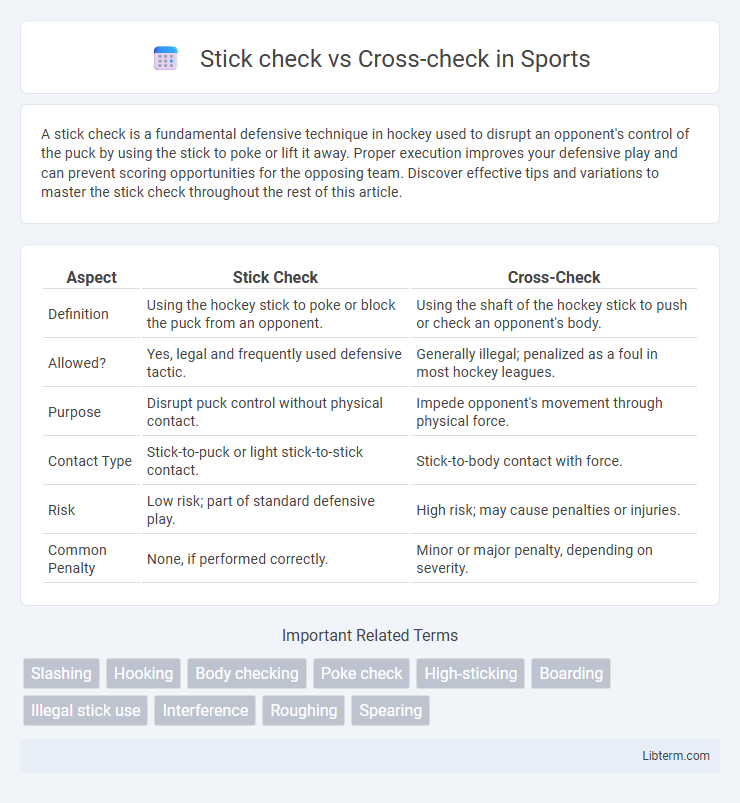A stick check is a fundamental defensive technique in hockey used to disrupt an opponent's control of the puck by using the stick to poke or lift it away. Proper execution improves your defensive play and can prevent scoring opportunities for the opposing team. Discover effective tips and variations to master the stick check throughout the rest of this article.
Table of Comparison
| Aspect | Stick Check | Cross-Check |
|---|---|---|
| Definition | Using the hockey stick to poke or block the puck from an opponent. | Using the shaft of the hockey stick to push or check an opponent's body. |
| Allowed? | Yes, legal and frequently used defensive tactic. | Generally illegal; penalized as a foul in most hockey leagues. |
| Purpose | Disrupt puck control without physical contact. | Impede opponent's movement through physical force. |
| Contact Type | Stick-to-puck or light stick-to-stick contact. | Stick-to-body contact with force. |
| Risk | Low risk; part of standard defensive play. | High risk; may cause penalties or injuries. |
| Common Penalty | None, if performed correctly. | Minor or major penalty, depending on severity. |
Stick Check vs Cross-Check: Key Differences
Stick check involves using the hockey stick to legally poke or lift an opponent's stick to regain puck possession, emphasizing precision and timing within the rules. Cross-check occurs when a player forcefully pushes an opponent with the shaft of the stick held between both hands, often leading to penalties due to its aggressive nature. Understanding these distinctions is crucial for players to maintain aggressive defense while avoiding infractions in hockey gameplay.
Definition of Stick Check
A stick check is a defensive hockey move where a player uses their stick to quickly poke or lift an opponent's stick to disrupt puck control and prevent scoring opportunities. This technique aims to legally separate the puck from the opponent without physical contact that would lead to penalties. Stick checks are fundamental in maintaining defensive pressure and controlling the pace of the game.
Definition of Cross-Check
Cross-check involves using the shaft of the hockey stick with both hands to impede an opponent by forceful or prolonged contact, which is penalized under NHL rules for its potential to cause injury. Unlike a stick check, where a player uses the stick primarily to poke or lift the opponent's stick or puck, a cross-check is characterized by hitting or pushing an opponent with the stick held between two hands. This illegal action results in penalties such as minor or major penalties depending on the severity and intent during the game.
Legalities and Rules in Hockey
Stick checking involves using the stick to legally impede an opponent's movement or control of the puck, adhering strictly to NHL rules that prohibit contact above the shoulders or slashing. Cross-checking, defined by forceful contact with the shaft of the stick held with two hands, is penalized under NHL and IIHF regulations as it poses higher injury risks, often resulting in minor or major penalties. Referees enforce these distinctions to maintain player safety and fair play, reflecting the sport's commitment to regulated physicality.
Techniques for Effective Stick Checks
Effective stick checks require precise timing, control, and angling to legally disrupt an opponent's possession without incurring penalties. Mastering the technique involves using the blade to swiftly and cleanly contact the puck or stick while avoiding high or cross-contact that leads to cross-checking infractions. Proper stance and stick positioning enable players to maximize reach and leverage, ensuring stick checks are both safe and strategically advantageous.
Techniques for Effective Cross-Checks
Effective cross-checks in hockey require precise timing and controlled stick placement to avoid penalties and maintain defensive pressure. Techniques include using the shaft of the stick to apply lateral force on an opponent's stick while maintaining body positioning to disrupt puck control without excessive contact. Proper angles and footwork enhance leverage, enabling a successful cross-check that limits the opponent's movement and creates turnover opportunities.
Penalties and Consequences
Stick checking involves using the shaft of the stick to legally knock the puck away, while cross-checking refers to forcefully using the shaft between both hands to hit an opponent. Cross-check penalties result in minor or major penalties depending on the severity, often leading to power plays or player ejections. Stick check penalties occur less frequently but may incur minor penalties if the action is deemed high sticking or slashing, directly impacting game momentum and team strategy.
Situational Usage on the Ice
Stick checks are commonly employed during close puck battles and faceoffs to quickly disrupt an opponent's control without excessive force, ideal for maintaining defensive positioning. Cross-checking involves using the shaft of the stick with both hands to apply pressure, often utilized to slow down or separate an attacking player when physical space is limited. Referees closely monitor cross-checks for penalties, especially during high-contact zones like the crease or along the boards.
Player Safety and Risks
Stick check and cross-check are distinct defensive techniques in hockey with varying impacts on player safety. Stick checking involves using the stick to legally poke or sweep the puck away, minimizing physical contact and reducing injury risks. Cross-checking, which involves forceful contact with the shaft of the stick against an opponent's body, significantly increases the risk of injuries such as bruises, fractures, and concussions, leading to stricter penalties to protect players.
Improving Your Defensive Game
Mastering the difference between stick checks and cross-checks is essential for improving your defensive game in hockey. Stick checks involve using your stick to poke or sweep the puck away from an opponent, enhancing puck control and disrupting plays without risking penalties. Cross-checking, which entails using the shaft of your stick to push an opponent, is less effective defensively and often results in penalties, making stick checks the preferred technique for disciplined, effective defense.
Stick check Infographic

 libterm.com
libterm.com